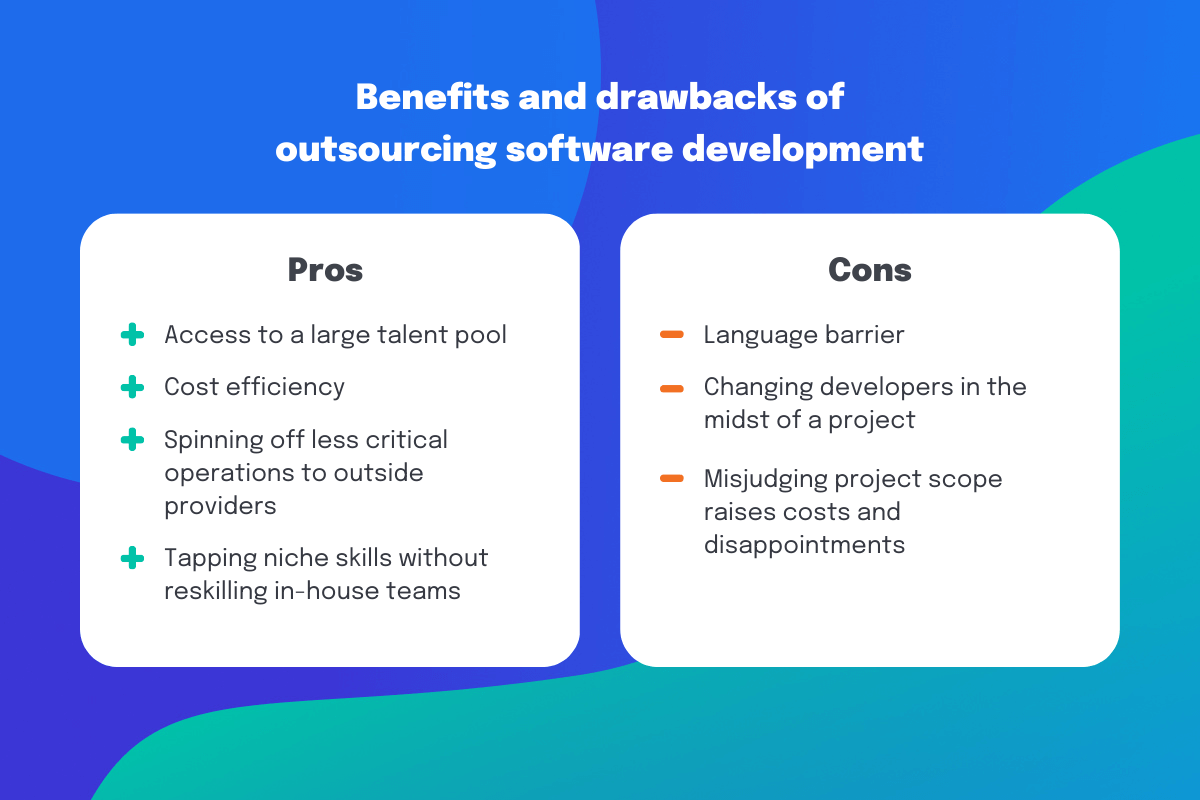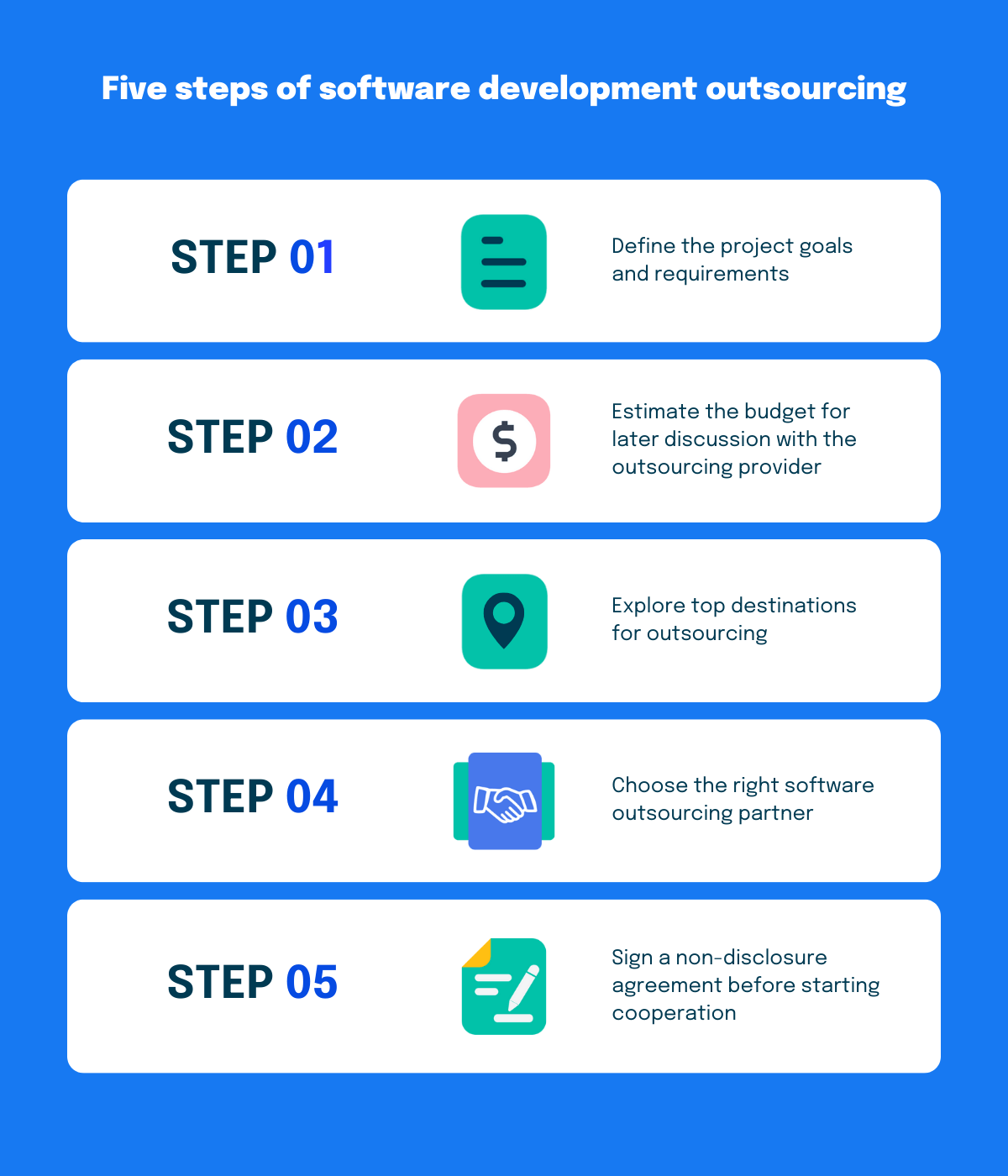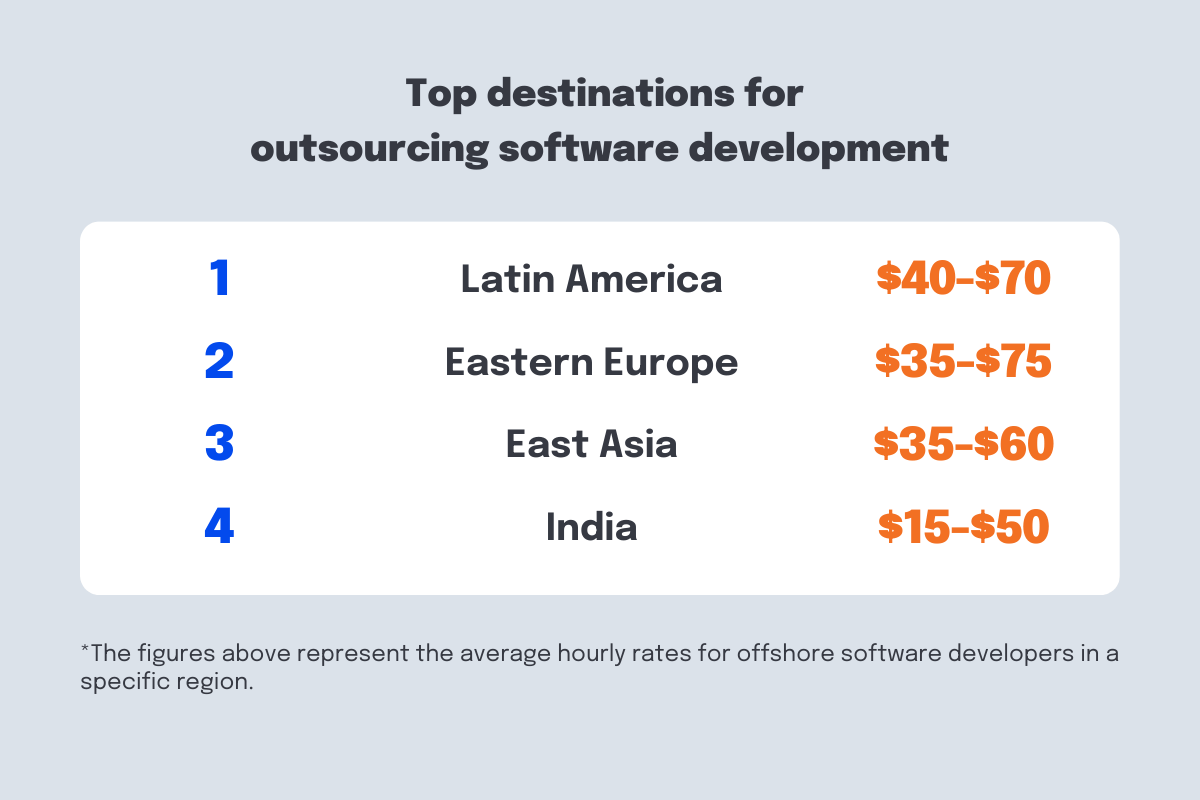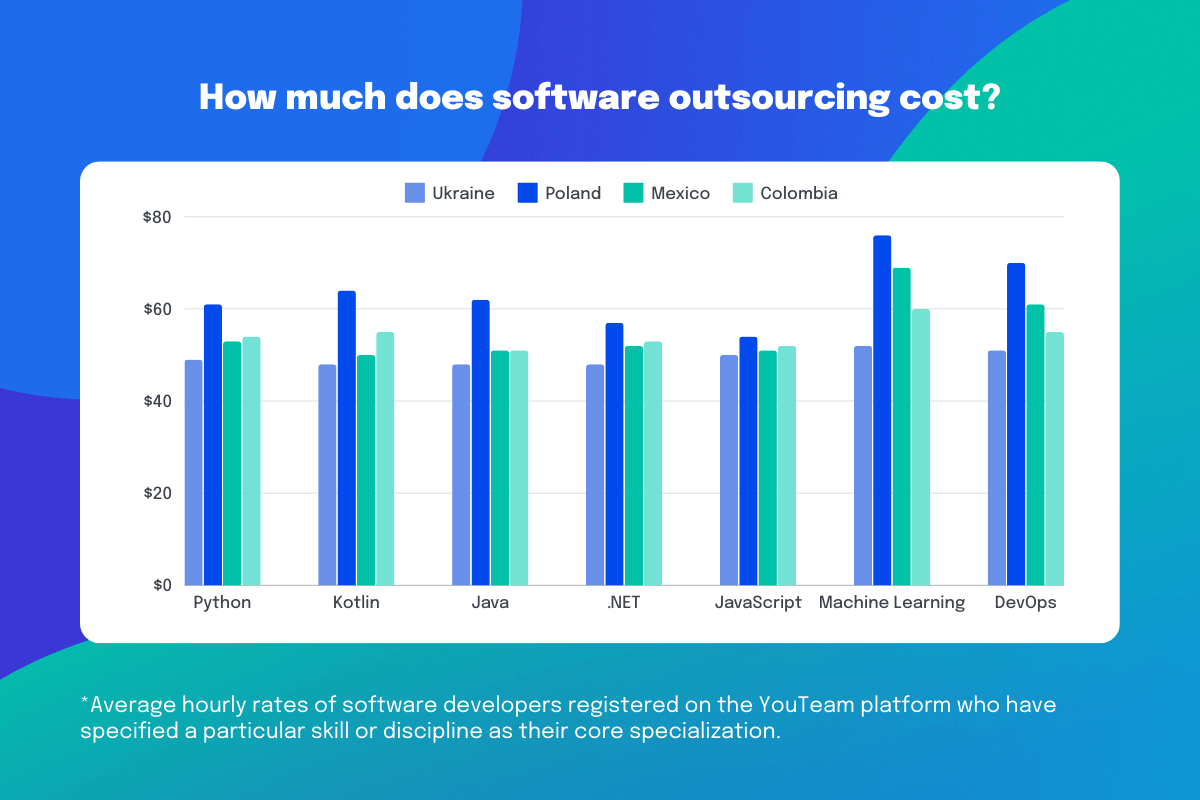In this comprehensive overview of software development outsourcing, we discuss the specific characteristics of four outsourcing models, introduce a step-by-step plan for choosing the right software development provider, and explore top countries where you can hire software teams for your next project. We have also compiled software development hourly rates in the context of popular programming languages and skills required for modern projects.
In the FAQ section, we outline the most critical questions to ask when contacting an outsourcing provider and address concerns about intellectual property ownership and project cost estimation.
Table of Contents
What is software development outsourcing?
Software development outsourcing is a business practice in which a company hires a third party to perform tasks or provide services on a contract basis. In software engineering, such tasks include app development, legacy system maintenance, testing, and quality assurance services.
Historically, organizations have chosen to outsource software development to implement their digital transformation primarily because of cost savings. The practice of outsourcing software development to a third party aimed to reduce labor costs, including salaries, overhead, and office equipment. However, cost reduction is no longer the top priority. Today, the primary strategy is to shorten the long recruitment path and get quick access to cutting-edge technologies and the best engineering talent.
In addition to providing access to developers with specific skill sets and experience that might not be readily available in the local market, software development outsourcing relieves the company of the obligation to integrate new specialists into the internal team and develop a long-term plan for their career development. It also relieves the in-house team of non-essential tasks, allowing them to concentrate on core product development and more strategic tasks.
The IT outsourcing market, comprising software development, infrastructure management, cloud services, and technical support, is projected to reach $512.5 billion in revenue in 2024, solidifying software outsourcing as one of the most influential and widespread business practices.
What are the advantages of software development outsourcing?
Companies opt for software development outsourcing to reduce costs, relieve the in-house team of backlogged projects and non-essential tasks, or access engineers with niche expertise that may not be readily available in the local market. Moreover, outsourcing is a flexible business practice that proves useful when a project requires specific expertise that the company doesn’t have in its stack, and the company doesn’t need that expertise once the project is completed. Let’s dive into more details about the advantages of outsourcing:
1. Access to a wide talent pool.
Outsourcing software development implies connecting with a robust talent pool to identify the ideal candidate with the required skill set, domain expertise, and professional preferences. The contracting company typically has internal recruiters to find the best candidates for the role or pre-vetted engineers who may have the skills required for your project.
2. Cost efficiency.
Software companies choose outsourcing to cut recruiting and development costs. Partnering with companies that offer a wide talent pool of professionals allows businesses to avoid spending a lot of time and resources searching for an experienced developer or someone with highly sought-after expertise. In addition, third-party providers focus on specific tasks, which means they can perform them better, faster, and more cost-effectively than the hiring company.
Finally, with software development outsourcing, companies don’t need to bother about benefits, retirement contributions, and other costs associated with hiring and managing an internal team, even though such costs are, in fact, included in the outsourcing development rates.
3. Flexibility.
Hiring an outsourcing agency allows companies to focus on the core elements of their business, spinning off the less critical operations to outside providers.
Additionally, companies can ramp up their development to keep up with demand for the product without the long-term financial commitment of hiring in-house employees, which can take years to pay off. This makes software development outsourcing particularly valuable for projects with fluctuating demand.
In the case of hiring contractors through staff augmentation, if a software developer is not a good fit for the company, it is easier to end the relationship or replace them with someone else. In contrast, laying off in-house developers is more difficult because the company must provide advance notice and severance pay.
4. Tapping niche skills without reskilling your in-house team.
It can take months for internal teams to learn niche disciplines such as machine learning, data engineering, and extended reality (XR) technology, or to master specific services such as cloud migration or automating manufacturing processes. Outsourcing software development instantly opens the door to professionals with comprehensive experience in these fields.
In other words, companies look to outsourcing providers as innovation centers with access to cutting-edge technologies and more specialized engineering talent. Shifting extraneous functions to companies with a history of handling them can lead to greater productivity and cost-effectiveness.
Another case of software outsourcing is when a company has legacy software that needs upgrading. Therefore, it may need experienced contractors with knowledge of both the code structure of the legacy system and newer tools and languages.
For instance, cloud advisory services play a pivotal role in this transformation by offering companies the means to seamlessly bridge the gap between legacy systems and the latest technologies.
5. Improved quality.
Outsourcing companies have well-established quality assurance policies and procedures. In addition, outsourcing providers can bring a fresh perspective to software development and help companies find new ways to improve their products and services. When an internal team is overloaded with tasks, outsourcing software development can be an effective way to invest in a new project or reduce old technical debt.
What are the disadvantages of software development outsourcing?
The most common pitfalls of outsourcing software development are often linked to a lack of communication and control, as well as language barriers:
1. Language barrier.
Programmers need to be strong and competent communicators who can ask the right questions and seek clarification when necessary. Building and maintaining a software product is not only about developing a good application. A more important task is to ensure that the product meets the customer’s requirements while optimizing solutions for specific tasks.
Therefore, software developers must delve into the specific details of the product and communicate effectively with different teams within the organization, including the product team, customer support, and sales. With that in mind, a limited vocabulary can significantly reduce a developer’s ability to understand the complete picture and offer the right solutions.
2. Changing developers in the midst of a project.
If the agency doesn’t have a well-defined procedure for maintaining project documentation, the departure of one or more team members can lead to delays and lower-quality results.
3. Assigning an entire project to an outsourced team means transferring full responsibility for the project’s outcomes to this team.
When a company hires people through staff augmentation or builds an internal team, the responsibility for knowledge transfer and effective documentation rests with the company. Moreover, hiring full-time contractors or internal employees implies that the company has technical managers who can evaluate the team’s productivity and monitor development progress.
However, if a company decides to outsource an entire project to an agency, it typically has less control over it, and the compliance of the final product with the customer’s requirements and industry best practices becomes a matter of the agency’s diligence.
4. Failure to understand the scope of the project can result in an increased budget and unmet expectations.
This scenario is particularly relevant to fixed price contracts. Before entrusting development to an outsourced team, a company needs to clearly define the requirements, expected outcomes, timeline, and overall scope of the project. Failure to communicate these details can lead to an uncontrolled scope growth and disagreements about the product’s vision and functionality. In project-based outsourcing, software engineers work in silos, so to bridge the gap between expectations and actual results, the company should clearly outline the desired elements and features in the specification.
Software development outsourcing models
We have outlined the most well-known advantages and disadvantages for each model of cooperation with an outsourcing agency. This section summarizes the key characteristics specific to each model. It is important to note that all the models share the common software outsourcing strengths and weaknesses identified in the previous segments.
| Fixed price | Time and materials | Dedicated team | Staff augmentation | |
| Project size | Small | Small; medium | Large | Large |
| Business requirements | Fixed and pre-defined | Dynamic and flexible | Adapt as innovation progresses | Adapt as innovation progresses |
| Scope and resources | Clearly defined | Unclear or roughly estimated | Unclear or roughly estimated | Unclear or roughly estimated |
| Client control | Zero to little | Substantial | Full | Full |
Fixed price contract
This contractual agreement has a clearly defined scope of work and a list of resources required to complete the project. A fixed-price contract outlines the project’s deliverables, milestones, and any specific requirements for the provider. The client and software outsourcing provider then agree on a pre-determined, fixed price.
Time and materials contract
The time and materials (T&M) outsourcing model is a type of contractual agreement that involves regular payments for the work delivered. The client pays for the actual time that the outsourced team members spent on development and covers material costs associated with the project, such as hardware, software licenses and subscriptions, or travel expenses.
Hiring a dedicated team
Companies hire dedicated teams when they require continuous software development and support. In this approach, the software outsourcing provider, with the active participation of the client, forms a team that will be fully dedicated to a specific long-term project. They interview internal or external candidates to assess whether their skills and experience match the project’s specific requirements. The client can scale the number of dedicated team members up or down over the course of the collaboration, depending on the actual project requirements and goals.
Staff augmentation model
Staff augmentation is a business practice where full-time contractors, employed by a software outsourcing agency, are hired to perform a specific amount of work under the direct supervision of the client. This approach effectively resolves all the communication issues that project-based outsourcing can involve. The difference between dedicated teams and staff augmentation is that the latter doesn’t involve hiring a project manager from an outsourcing company. The staff augmentation practice shares both the advantages and disadvantages of the dedicated team model.
Top destinations for outsourcing software development
When we think about outsourcing software development, we often consider countries like Poland, Ukraine, Taiwan, India, or Mexico, which have a growing pool of talented software engineers and significant investments in technical education and scientific research.
In addition, the rates for outsourcing services in these countries are typically lower than in North America or Western Europe, where software development services can cost $100/hour or more. Next, we will explore the top destinations with a long history of outsourcing software development which are home to providers who have extensive experience in software engineering.
Eastern Europe
A “tech talent goldmine,” Eastern Europe produces highly competitive software developers who are constantly striving for knowledge. The region is home to nearly 1 million professional software developers, offering an attractive cost-to-quality ratio, with software developer average rates ranging from $35 to $75 per hour.
Eastern European countries have cultural and linguistic histories influenced by both the Western and Eastern worlds. They have deep economic and cultural ties with both Western Europe and North America, with most of these countries being members of the European Union (with Ukraine as an EU candidate).
The region is historically recognized for its education with a focus on technical knowledge. Modern education continues this tradition, with software engineers earning computer science degrees at both bachelor’s and master’s levels. These programs focus on theoretical computer science, telecommunications, artificial intelligence, distributed computing, and software engineering.
According to Coursera’s 2023 Global Skills Report, which evaluated the skills of 120 million registered learners in 100 countries, five Eastern European countries – Slovakia, Ukraine, Bulgaria, Belarus, and Poland – ranked in the top 25 countries in the areas of business, technology, and data science. In Europe as a whole, European learners prioritize data science skills such as artificial neural networks and deep learning, which are crucial in the emerging AI market.
Eastern European countries like Ukraine, Poland, and Bulgaria are globally recognized as top outsourcing destinations, having developers with extensive commercial experience and proficiency in various programming languages and frameworks. The region is also known for its cybersecurity, deep learning, and data science specialists. However, Europe’s tech sector faces pressure to maintain its reputation as a hot source of IT talent due to the Russian invasion of Ukraine, which has put the rapid growth of innovation in the territories near the conflict zone at risk.
Asia
India is known as the most popular outsourcing destination, primarily serving U.S. and U.K. companies with its exported IT services. The country has numerous high-profile universities that place a significant emphasis on technical education in fields such as engineering, quantum physics, artificial intelligence, telecommunications, computer networking, and machine learning.
India offers access to more than 5 million software developers, providing services at relatively low rates ranging from $15 to $50 per hour for custom software development. However, due to disproportionately low salaries, Indian software developers often turn to moonlighting in pursuit of additional sources of income. The reasons for seeking side projects are not only limited to low salaries but also include factors such as rising inflation and entrepreneurial ambitions. As a result, working an additional 4-5 hours after their regular 8-hour workday may affect their performance and agility.
China follows India as a country with one of the largest talent pools of engineers. However, the rates for Chinese offshore developers are higher than in India, with product development costs ranging from $35 to $60 per hour.
Other countries where hiring a dedicated offshore development team is popular include the Philippines, Vietnam, and Bangladesh. The total number of developers in the Asian region is around 15 million.
Latin America
Latin America is currently experiencing significant growth in the software development industry, with top locations including Argentina, Mexico, Brazil, Colombia, and Costa Rica. Hourly rates for offshore developers in these countries can vary from $40 to $70 per hour, depending on the developer’s qualifications.
Offshore software development companies in the region specialize in working with North American projects and are good at understanding their clients’ needs and requirements. One particular advantage of Latin America is its favorable time zone alignment with the United States. In addition, closer proximity allows software development teams to gain a thorough understanding of U.S. intellectual property laws. IP protection and data security are often top concerns for U.S. businesses of all sizes and industries.
The region is known for its vibrant tech communities, strong education, and thriving startup culture. Latin American countries are home to some of the most prestigious universities offering engineering and technology careers, such as Tecnológico de Monterrey in Mexico, the University of São Paulo in Brazil, and the University of the Andes in Colombia.
Brazil is particularly well known for its large talent pool, with more than 7,000 companies in the software development and production sector and more than 12,000 companies registered in the IT services segment as of 2021.
A step-by-step guide for software development outsourcing
Here are the crucial steps that will help you find the right software outsourcing partner for your development project.
We also believe that the best position to outsource software development is when the hiring company has a CTO or VP of Engineering who will run daily standups and monitor commits and pull requests. That kind of person will notice even subtle changes in performance and code quality, making it significantly more challenging for the agency to sell him an underperforming engineer.
Step 1. Define the project goals and requirements.
Documents for project planning and execution should include a summary of objectives, methods, tools, and frameworks to be used. They should also outline the desired set of skills and experience. In addition, the company’s technical specialists and hiring managers define performance-based requirements to set clear expectations for the software development vendor.
Project charter and scope of work documents are essential. The more specific you are about what you want to build, the better the software outsourcing company will understand your business goals, leading to better results.
Step 2. Estimate the budget roughly so that you can discuss it later with the outsourcing provider.
Identify the number of professionals to be hired, their average rates or salaries, and take into account the outsourcing company’s commission.
Consider lower outsourcing rates with caution. Not only can they imply lower-quality output, but some agencies may cut prices significantly in order to increase the budget at some point in the future. The nature of outsourcing means that the longer you work with an agency, the more you depend on it, and the more expensive it will be for you to replace it. So, if you find an agency with rates significantly lower than the market, without an obvious reason, consider it a warning sign.
Step 3. Explore countries for outsourcing software development.
The general criteria for choosing a country for outsourcing include talent quality and experience, cost-effectiveness, time zone overlap, language skills, political stability, and regulatory standards and compliance frameworks.
Eastern Europe and Latin America are expected to witness a growing number of software development contracts in the coming years. Engineers from popular outsourcing destinations such as Ukraine, Mexico, and Brazil often offer significantly lower rates than their U.S. counterparts. These engineers have hands-on experience in building products for U.S. companies, even though it’s done indirectly through their work at agencies.
On the other hand, software engineers in the United States will continue to advance their careers. If you prefer working with a company located in the same time zone and familiar with legal and intellectual property protection practices in the United States, consider outsourcing to U.S. software companies.
It’s also a good idea to collaborate with local or global hiring partners and marketplaces that are familiar with top universities and reliable software vendors in specific territories. They can provide valuable references.
Step 4. Choose the right software outsourcing partner.
You can visit review websites and online platforms to find contract software developers and development teams, depending on your project timeline and requirements:
- YouTeam: A staff augmentation marketplace where you can hire full-time vetted contractors;
- G2, Clutch: Review websites where you can find an outsourcing partner and assign the entire project to them or hire a dedicated team.
You can also search for software outsourcing providers on LinkedIn by filtering location and industry, or visit software developer events and tech conferences to meet developers in person.
Before deciding to reach out and sign the contract with a development agency, you should focus on their portfolio, industry expertise, and customer reviews. You should also check whether an outsourcing company follows international security standards and contractual agreements on intellectual property transfer and data protection.
Finally, ensure that the outsourced provider follows current software development best practices and can build reliable systems that verify identity, protect user data, and secure information exchanged within the app.
After reviewing the aforementioned criteria, you’ll narrow down the shortlist of the most suitable outsourcing companies.
Step 5. Protect your data and intellectual property.
When a company outsources a project, it must share confidential business information with the outsourcing partner. In a world where data breaches happen every day, it’s crucial to effectively manage sensitive information and control access to internal accounts to prevent it from falling into the hands of competitors or malicious actors.
Outsourcing companies are required to sign a non-disclosure agreement before starting cooperation. Additionally, you should verify whether the service provider conducts regular network and security audits at their workplace.
How to choose a development partner: Small outsourcing companies vs. large outsourcing companies
When choosing an outsourcing company, whether small, medium, or large, you should consider the scope of work and the required skill set.
Some people believe that when you have a small project, it’s better to approach a well-established brand with significant project management experience. However, such an agency is unlikely to take on a small project because it primarily deals with larger enterprises.
In contrast, small outsourcing companies can often be more proactive and offer a more personalized approach to clients. (However, it depends on how busy they are with projects.) In addition, when you choose a small boutique software development company, you often have the opportunity to communicate directly with top management. This allows you to gain valuable insights and advice on your project from experienced executives.
The advantage of large software outsourcing companies is that they often invest heavily in security measures and strictly adhere to industry development standards. This is particularly crucial for companies that prioritize data privacy. Furthermore, large outsourcing companies have a diverse talent pool, increasing the likelihood of finding specialists who can meet complex and niche requirements.
How much does software development outsourcing cost?
We’ve listed the popular programming languages and skills required for modern software projects. The figures below reflect the average hourly rates of software developers registered on the YouTeam platform who have specified a particular skill or discipline as their core specialization.
| Ukraine | Poland | Colombia | Mexico | |
| Golang | $53 | $53 | $55 | $51 |
| Python | $49 | $61 | $54 | $53 |
| Rust | $58 | No data | No data | No data |
| Kotlin | $48 | $64 | $55 | $50 |
| Java | $48 | $62 | $51 | $51 |
| C++ | $51 | $66 | $64 | $56 |
| .NET | $48 | $57 | $53 | $52 |
| JavaScript | $50 | $54 | $52 | $51 |
| Node.js | $50 | $53 | $53 | $51 |
| iOS Development | $50 | $56 | $55 | $50 |
| Data Analysis | $62 | No data | $54 | $50 |
| Machine Learning | $52 | $76 | $60 | $69 |
| DevOps | $51 | $70 | $55 | $61 |
| Blockchain Engineering | $70 | No data | $61 | No data |
*Average hourly rates. Source: YouTeam.
Hiring software developers with YouTeam
The process of hiring software engineers with YouTeam looks like this:
- You request a call and describe your development project goals and vision of the ideal candidate.
- Your Matching Expert creates an Ideal Candidate Profile that meets your criteria, such as tech stack, industry experience, and professional development preferences.
- Alternatively, if you don’t have enough time to make calls, you can start with our AI assistant, which will gather all the necessary information to find and screen candidates.
- YouTeam finds suitable engineers among hundreds of partner outsourcing agencies. Our experts pre-screen talent to create a shortlist of candidates who most closely match your Ideal Candidate Profile. The first batch of profiles will be ready in 48 hours.
- You receive and review your candidate shortlist and select which software engineers you want to interview. If you are not satisfied with your shortlist, the Matching Expert will source new candidates. [We have not encountered such cases in our practice, but we are ready to handle them upon your request.]
- The final stage is contract signing. YouTeam contracts are locally-compliant and standardized, saving you time in case of hiring several developers from different agencies.
- The platform ensures secure intellectual property (IP) transfer and guarantees the implementation of security measures to prevent unauthorized processing of personal data.
- YouTeam offers free replacements, a 1-month risk-free trial period, and a money-back policy.
Frequently Asked Questions
What are the benefits of software development outsourcing?
Outsourcing software development is a flexible business practice that proves useful when a project requires specific expertise that the company doesn’t have in its stack, and the company doesn’t need that expertise once the project is completed. The most common advantages of outsourcing software development are as follows:
- Access to a wide talent pool.
- Cost efficiency and reduced recruitment time.
- Flexibility to scale up or down the development team, make replacements, and end relationships.
- Tapping niche skills without reskilling your in-house team.
- Well-established quality assurance policies and procedures.
What are the disadvantages of software development outsourcing?
The most common pitfalls of outsourcing are often linked to a lack of communication and control, as well as language barriers:
- Changing developers in the midst of a project can lead to delays.
- Assigning an entire project to an outsourced team means transferring full responsibility for the project’s outcomes to this team.
- Failure to understand the scope of the project can result in an increased budget and unmet expectations.
- Language and culture barriers can significantly reduce a developer’s ability to understand the complete picture.
What are the questions to ask when outsourcing software development?
Here are some crucial questions you should ask when contacting an outsourcing provider:
- What is their portfolio of previous projects?
- What software development methodologies do they use?
- In which time zone is their development team located?
- How do they handle intellectual property rights and source code access?
- Do they have all the specialists on board, or do they plan to attract third-party developers to expand the team working with you?
Who owns intellectual property (IP) when outsourcing software development?
IP ownership remains with the client, but it’s essential to secure this legally. You should sign an agreement between your company and the developers that includes a clause guaranteeing the assignment of intellectual property rights to you. Don’t try to draft such an agreement from scratch; instead, look for a template that has been legally reviewed in your country. Apart from signing the contract, you can have the developers sign an additional document regarding the transfer of intellectual property rights after the product is delivered.
How do outsourcing firms estimate software development projects?
Here is how to begin turning an idea for software into an accurate project estimate:
- Clearly define the desired outcomes.
- Identify the decisions needed to achieve those outcomes.
- Break the project down into smaller parts and milestones.
- Use previous projects of a similar nature to create a cost estimate.
- Create a priority list of ‘must-haves’ and optional features for your software. This will give you a clear idea of what an MVP (Minimum Viable Product) should look like and cost, compared to the final version of the product with all the functionality.
With this information, you should have a list of features and milestones. Using this list, a team of developers can estimate the number of days/hours required to deliver the work.
What are the top destinations for software outsourcing?
Companies looking to outsource software development often choose countries like Poland, Ukraine, Taiwan, India, or Mexico. These countries have a large pool of experienced software engineers with strong technical backgrounds. In addition, the rates for software outsourcing in these regions are typically 1.5 times lower than in North America.
How to find the right software outsourcing partner?
To find the right software outsourcing partner, start by defining your project requirements and budget. Research countries with favorable outsourcing conditions, focusing on talent quality and cost-effectiveness. Choose a software outsourcing partner by evaluating their portfolio and customer feedback. Finally, protect your data and intellectual property by signing confidentiality agreements and verifying the outsourcing provider’s security measures.










